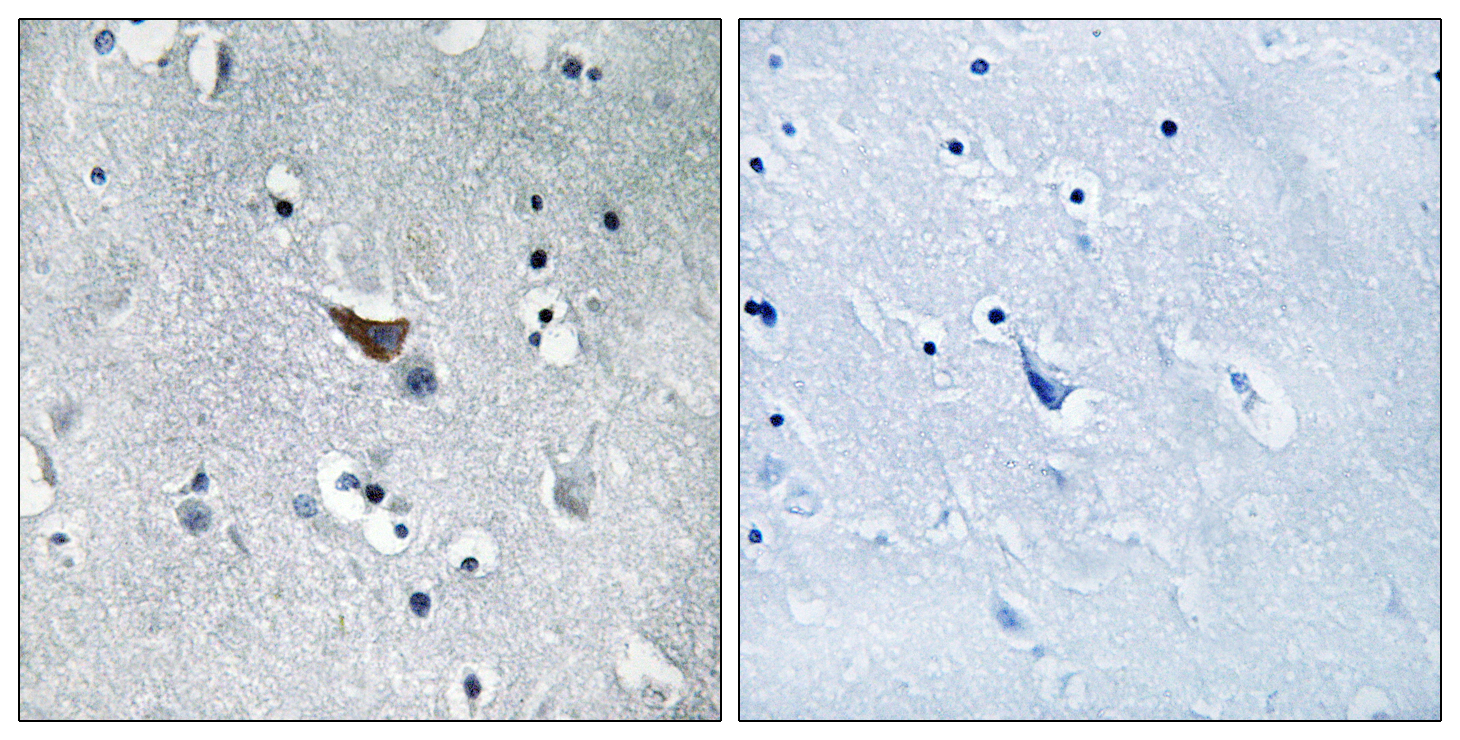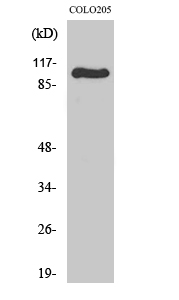产品名称
GluR-1 Rabbit Polyclonal Antibody
别名
GRIA1; GLUH1; GLUR1; Glutamate receptor 1; GluR-1; AMPA-selective glutamate receptor 1; GluR-A; GluR-K1; Glutamate receptor ionotropic; AMPA 1; GluA1
蛋白名称
Glutamate receptor 1
存储缓冲液
Liquid in PBS containing 50% glycerol, 0.5% BSA and 0.02% New type preservative N.
Human Gene Link
http://www.ncbi.nlm.nih.gov/sites/entrez?db=gene&term=2890
Human Swissprot No.
P42261
Human Swissprot Link
http://www.uniprot.org/uniprotkb/P42261/entry
Mouse Gene Link
http://www.ncbi.nlm.nih.gov/sites/entrez?db=gene&term=14799
Mouse Swissprot No.
P23818
Mouse Swissprot Link
http://www.uniprot.org/uniprot/P23818
Rat Gene Link
http://www.ncbi.nlm.nih.gov/sites/entrez?db=gene&term=50592
Rat Swissprot Link
http://www.uniprot.org/uniprot/P19490
免疫原
The antiserum was produced against synthesized peptide derived from human GluR1. AA range:816-865
特异性
GluR-1 Polyclonal Antibody detects endogenous levels of GluR-1 protein.
稀释度
WB 1:500 - 1:2000. IHC 1:100 - 1:300. IF 1:200 - 1:1000. ELISA: 1:40000. Not yet tested in other applications.
宿主
Polyclonal, Rabbit,IgG
背景介绍
Glutamate receptors are the predominant excitatory neurotransmitter receptors in the mammalian brain and are activated in a variety of normal neurophysiologic processes. These receptors are heteromeric protein complexes with multiple subunits, each possessing transmembrane regions, and all arranged to form a ligand-gated ion channel. The classification of glutamate receptors is based on their activation by different pharmacologic agonists. This gene belongs to a family of alpha-amino-3-hydroxy-5-methyl-4-isoxazole propionate (AMPA) receptors. Alternatively spliced transcript variants encoding different isoforms have been found for this gene. [provided by RefSeq, Jul 2008],
组织表达
Widely expressed in brain.
细胞定位
Cell membrane ; Multi-pass membrane protein . Endoplasmic reticulum membrane ; Multi-pass membrane protein . Cell junction, synapse, postsynaptic cell membrane ; Multi-pass membrane protein . Cell junction, synapse, postsynaptic density membrane ; Multi-pass membrane protein . Cell projection, dendrite . Cell projection, dendritic spine . Early endosome membrane ; Multi-pass membrane protein . Recycling endosome membrane ; Multi-pass membrane protein . Cell junction, synapse, presynapse . Cell junction, synapse . Interaction with CACNG2, CNIH2 and CNIH3 promotes cell surface expression. Colocalizes with PDLIM4 in early endosomes. Displays a somatodendritic localization and is excluded from axons in neurons (By similarity). Localized to cone photoreceptor pedicles (By similarity). .
信号通路
Neuroactive ligand-receptor interaction;Long-term potentiation;Long-term depression;Amyotrophic lateral sclerosis (ALS);
功能
function:Ionotropic glutamate receptor. L-glutamate acts as an excitatory neurotransmitter at many synapses in the central nervous system. Binding of the excitatory neurotransmitter L-glutamate induces a conformation change, leading to the opening of the cation channel, and thereby converts the chemical signal to an electrical impulse. The receptor then desensitizes rapidly and enters a transient inactive state, characterized by the presence of bound agonist.,miscellaneous:The postsynaptic actions of Glu are mediated by a variety of receptors that are named according to their selective agonists. This receptor binds AMPA (quisqualate) > glutamate > kainate.,PTM:Palmitoylated. Depalmitoylated upon glutamate stimulation. Cys-603 palmitoylation leads to Golgi retention and decreased cell surface expression. In contrast, Cys-829 palmitoylation does not affect cell surface expression but regulates stimulation-dependent endocytosis.,similarity:Belongs to the glutamate-gated ion channel (TC 1.A.10) family.,subcellular location:Interaction with CACNG2 promotes cell surface expression.,subunit:Homotetramer or heterotetramer of pore-forming glutamate receptor subunits. Tetramers may be formed by the dimerization of dimers. Interacts with DLG1 via its C-terminus. Interacts with CACNG2, HIP1 and RASGRF2.,tissue specificity:Widely expressed in brain.,
纯化
The antibody was affinity-purified from rabbit antiserum by affinity-chromatography using epitope-specific immunogen.





